Air Conditioning Systems Fault Detection and Diagnosis-Based Sensing and Data-Driven Approaches
Abstract
1. Introduction and Literature Review
2. Research Scope and Methodology
3. Major Common Faults in Air Conditioning Systems
4. Fault Detection and Diagnostic Techniques for Air Conditioning
5. Sensor Deployment and Data Source Architecture
6. Synthesis and Contribution
6.1. Synthesis and Discussion
- Identifying an optimal sensor architecture to detect a maximal number of faults with a minimal number of sensors.
- Developing new FDD methods to detect simultaneous faults in AC systems with a greater on soft faults.
- The development of FDD methods capable of being deployed for each type of AC system without considering the AC size (e.g., large-scale, multi-family, single-family, residential AC unit) or the manufacturer.
- Investigating new online FDD methods capable of detecting the abnormal operation of AC systems without planning a shutdown time for the system.
- The investigation of new FDD methods based on the Internet of Things. The AC system is a system that will be improved into a smart service in the building in a way to be connected to other services at the same time as the cloud computing services. In this case, the deployment of machine learning algorithms for FDD will be robust.
- The use of social sensing methods together with the actual FDD methods is a main research motivation to minimize the cost of the sensors deployed in the AC system to detect faults.
- The FDD methods-based, data-driven approaches should be improved to have the capability to be deployed in isolated areas where the AC system is not connected to the internet. This research motivation is boosted by the development of new machine learning algorithms and artificial intelligence methods that minimize the processing time and reduce the required computing performance [65,66].
6.2. Contribution
- Selecting the list of common and frequent faults as the objective of the FDD method.
- Identifying the optimal sensor position and number capable of detecting the maximal number of common faults without having redundant data.
- Collecting the data during normal and faulty cases.
- Training the first ANN model (Figure 8) using the compressor power consumption dataset and the indoor/outdoor operational context (i.e., temperature, humidity). This step allows us to detect two cases: normal operation or faulty operation. It requires less processing and data analysis performance, and it allows you to detect faults at their beginning.
- In the case of fluctuated compressor power consumption for the same operation context used for the training, the Extra Tree Classifier model starts the analysis of the other measurements (e.g., compressor vibration and temperature, refrigerant pressure, input/output condenser, and evaporator temperature) in a way to identify, from the fault library, the equivalent fault cause of this fluctuation.
- Detecting simultaneous faults based on the library fault. In the case of faults that have similar symptoms, another sensor should be added to distinguish the two similar faults, which is the role of the optimal sensing step.
7. Conclusions and Perspectives
- Significant energy can be saved by the proper diagnosis of AC systems. Simultaneous faults should be detected as quickly as possible, requiring robust methods for detection, classification, and diagnostics. The new FDD-based, data-driven approaches should be capable of being deployed in isolated areas where the AC system is not connected to the internet.
- The development of information and communication technologies is a key to improving the efficiency of AC systems. The use of artificial intelligence is a factor that can help automate the system with the deployment of new methods for predictive maintenance. The Internet of Things concept should be integrated into AC system monitoring and control to make the system more interactive with its environment and especially with the occupant. Additionally, the use of the Internet of Things helps with the data collection and processing integrated for the development of new control and predictive maintenance methods.
- AC systems can be connected with other building services for optimal control and also for the integration of new concepts such as virtual sensing in order to have a larger dataset for monitoring and fault detection. Weather conditions datasets are interconnected with the system control for optimal operation to achieve rated efficiency.
- Research should consider the context-driven awareness of AC systems to minimize the energy consumed and maintain maximal occupancy comfort. The occupancy and activity detection in the building are the main keys to optimally controlling the AC system in a way to minimize the use of this massive consummator of energy. The use of new information and communication technologies, especially the Internet of Things, is an interesting concept used to make the AC system a “smart service” that interacts with the end user and with other services.
- The use of machine learning methods is an interesting key for future work in order to develop new methods for fault detection, diagnostics, and AC system control. The identification of accurate machine learning algorithms for parameter prediction and data classification is required for precise FDD deployment.
Author Contributions
Funding
Data Availability Statement
Conflicts of Interest
References
- International Energy Agency. Global Energy Review 2021: Electricity Demand. Available online: https://www.iea.org/reports/global-energy-review-2021/electricity (accessed on 20 September 2022).
- Wu, J.; Xu, Z.; Jiang, F. Analysis and development trends of Chinese energy efficiency standards for room air conditioners. Energy Policy 2019, 125, 368–383. [Google Scholar] [CrossRef]
- Ahmad, J.; Larijani, H.; Emmanuel, R.; Mannion, M.; Javed, A. Occupancy detection in non-residential buildings—A survey and novel privacy preserved occupancy monitoring solution. Appl. Comput. Inform. 2021, 17, 279–295. [Google Scholar] [CrossRef]
- Che, W.; Tso, C.Y.; Sun, L.; Ip, D.Y.; Lee, H.; Chao, Y.H.C.; Lau, A.K. Energy consumption, indoor thermal comfort and air quality in a commercial office with retrofitted heat, ventilation and air conditioning (HVAC) system. Energy Build. 2019, 201, 202–215. [Google Scholar] [CrossRef]
- Tang, R.; Wang, S. Model predictive control for thermal energy storage and thermal comfort optimization of building demand response in smart grids. Appl. Energy 2019, 242, 873–882. [Google Scholar] [CrossRef]
- Kharbouch, A.; Berrabah, S.; Bakhouya, M.; Gaber, J.; El Ouadghiri, D.; Kaitouni, S.I. Experimental and Co-Simulation Performance Evaluation of an Earth-to-Air Heat Exchanger System Integrated into a Smart Building. Energies 2022, 15, 5407. [Google Scholar] [CrossRef]
- Yan, X.; Guan, T.; Fan, K.; Sun, Q. Novel double layer BiLSTM minor soft fault detection for sensors in air-conditioning system with KPCA reducing dimensions. J. Build. Eng. 2021, 44, 102950. [Google Scholar] [CrossRef]
- Rogers, A.; Guo, F.; Rasmussen, B. A review of fault detection and diagnosis methods for residential air conditioning systems. Build. Environ. 2019, 161, 106236. [Google Scholar] [CrossRef]
- Torabi, N.; Gunay, H.B.; O’Brien, W.; Moromisato, R. Inverse model-based virtual sensors for detection of hard faults in air handling units. Energy Build. 2021, 253, 111493. [Google Scholar] [CrossRef]
- Pelella, F.; Viscito, L.; Mauro, A. Soft faults in residential heat pumps: Possibility of evaluation via on-field measurements and related degradation of performance. Energy Convers. Manag. 2022, 260, 115646. [Google Scholar] [CrossRef]
- Hu, Y.; Yuill, D.P. Impacts of common faults on an air conditioner with a microtube condenser and analysis of fault characteristic features. Energy Build. 2022, 254, 111630. [Google Scholar] [CrossRef]
- da Cunha, S.R.L.; de Aguiar, J.L.B. Phase change materials and energy efficiency of buildings: A review of knowledge. J. Energy Storage 2020, 27, 101083. [Google Scholar] [CrossRef]
- Elkhoukhi, H.; NaitMalek, Y.; Bakhouya, M.; Berouine, A.; Kharbouch, A.; Lachhab, F.; Hanifi, M.; El Ouadghiri, D.; Essaaidi, M. A platform architecture for occupancy detection using stream processing and machine learning approaches. Concurr. Comput. Pract. Exp. 2020, 32, e5651. [Google Scholar] [CrossRef]
- Elmouatamid, A.; Ouladsine, R.; Bakhouya, M.; El Kamoun, N.; Khaidar, M.; Zine-Dine, K. Review of control and energy management approaches in micro-grid systems. Energies 2020, 14, 168. [Google Scholar] [CrossRef]
- Zhou, Z.; Wang, J.; Chen, H.; Wei, W.; Xu, C. An online compressor liquid floodback fault diagnosis method for variable refrigerant flow air conditioning system. Int. J. Refrig. 2020, 111, 9–19. [Google Scholar] [CrossRef]
- Guo, Y.; Li, G.; Chen, H.; Hu, Y.; Li, H.; Liu, J.; Hu, M.; Hu, W. Modularized PCA method combined with expert-based multivariate decoupling for FDD in VRF systems including indoor unit faults. Appl. Therm. Eng. 2017, 115, 744–755. [Google Scholar] [CrossRef]
- Wang, J.; Li, G.; Chen, H.; Liu, J.; Guo, Y.; Hu, Y.; Li, J. Liquid floodback detection for scroll compressor in a VRF system under heating mode. Appl. Therm. Eng. 2017, 114, 921–930. [Google Scholar] [CrossRef]
- Liu, J.; Li, G.; Chen, H.; Wang, J.; Guo, Y.; Li, J. A robust online refrigerant charge fault diagnosis strategy for VRF systems based on virtual sensor technique and PCA-EWMA method. Appl. Therm. Eng. 2017, 119, 233–243. [Google Scholar] [CrossRef]
- Liu, J.; Liu, J.; Chen, H.; Yuan, Y.; Li, Z.; Huang, R. Energy diagnosis of variable refrigerant flow (VRF) systems: Data mining technique and statistical quality control approach. Energy Build. 2018, 175, 148–162. [Google Scholar] [CrossRef]
- Wang, Y.; Li, Z.; Chen, H.; Zhang, J.; Liu, Q.; Wu, J.; Shen, L. Research on diagnostic strategy for faults in VRF air conditioning system using hybrid data mining methods. Energy Build. 2021, 247, 111144. [Google Scholar] [CrossRef]
- Zhou, Z.; Li, G.; Wang, J.; Chen, H.; Zhong, H.; Cao, Z. A comparison study of basic data-driven fault diagnosis methods for variable refrigerant flow system. Energy Build. 2020, 224, 110232. [Google Scholar] [CrossRef]
- Sulaiman, N.A.; Abdullah, M.P.; Abdullah, H.; Zainudin, M.N.S.; Yusop, A.M. Fault detection for air conditioning system using machine learning. IAES Int. J. Artif. Intell. 2020, 9, 109. [Google Scholar] [CrossRef]
- Jan, S.U.; Lee, Y.D.; Koo, I.S. A distributed sensor-fault detection and diagnosis framework using machine learning. Inf. Sci. 2021, 547, 777–796. [Google Scholar] [CrossRef]
- Kim, W.; Lee, J.-H. Fault detection and diagnostics analysis of air conditioners using virtual sensors. Appl. Therm. Eng. 2021, 191, 116848. [Google Scholar] [CrossRef]
- Zhao, Y.; Li, T.; Fan, C.; Lu, J.; Zhang, X.; Zhang, C.; Chen, S. A proactive fault detection and diagnosis method for variable-air-volume terminals in building air conditioning systems. Energy Build. 2019, 183, 527–537. [Google Scholar] [CrossRef]
- Ranade, A.; Provan, G.; Mady, A.E.-D.; O’Sullivan, D. A computationally efficient method for fault diagnosis of fan-coil unit terminals in building Heating Ventilation and Air Conditioning systems. J. Build. Eng. 2020, 27, 100955. [Google Scholar] [CrossRef]
- Han, H.; Cao, Z.; Gu, B.; Ren, N. PCA-SVM-based automated fault detection and diagnosis (AFDD) for vapor-compression refrigeration systems. HvacR Res. 2010, 16, 295–313. [Google Scholar] [CrossRef]
- Hassanpour, H.; Mhaskar, P.; House, J.M.; Salsbury, T.I. A hybrid modeling approach integrating first-principles knowledge with statistical methods for fault detection in HVAC systems. Comput. Chem. Eng. 2020, 142, 107022. [Google Scholar] [CrossRef]
- Gálvez, A.; Diez-Olivan, A.; Seneviratne, D.; Galar, D. Fault detection and RUL estimation for railway HVAC systems using a hybrid model-based approach. Sustainability 2021, 13, 6828. [Google Scholar] [CrossRef]
- Yan, K.; Ji, Z.; Shen, W. Online fault detection methods for chillers combining extended kalman filter and recursive one-class SVM. Neurocomputing 2017, 228, 205–212. [Google Scholar] [CrossRef]
- Xie, X.; Merino, J.; Moretti, N.; Pauwels, P.; Chang, J.Y.; Parlikad, A. Digital twin enabled fault detection and diagnosis process for building HVAC systems. Autom. Constr. 2023, 146, 104695. [Google Scholar] [CrossRef]
- Wang, L.; Braun, J.; Dahal, S. An evolving learning-based fault detection and diagnosis method: Case study for a passive chilled beam system. Energy 2023, 265, 126337. [Google Scholar] [CrossRef]
- Shen, C.; Zhang, H.; Meng, S.; Li, C. Augmented data driven self-attention deep learning method for imbalanced fault diagnosis of the HVAC chiller. Eng. Appl. Artif. Intell. 2023, 117, 105540. [Google Scholar] [CrossRef]
- Albayati, M.G.; Faraj, J.; Thompson, A.; Patil, P.; Gorthala, R.; Rajasekaran, S. Semi-supervised machine learning for fault detection and diagnosis of a rooftop unit. Big Data Min. Anal. 2023, 6, 170–184. [Google Scholar] [CrossRef]
- Yan, K.; Zhou, X. Chiller faults detection and diagnosis with sensor network and adaptive 1D CNN. Digit. Commun. Netw. 2022, 8, 531–539. [Google Scholar] [CrossRef]
- Bai, X.; Zhang, M.; Jin, Z.; You, Y.; Liang, C. Fault detection and diagnosis for chiller based on feature-recognition model and kernel discriminant analysis. Sustain. Cities Soc. 2022, 79, 103708. [Google Scholar] [CrossRef]
- Li, W.; Gong, G.; Fan, H.; Peng, P.; Chun, L. Meta-learning strategy based on user preferences and a machine recommendation system for real-time cooling load and COP forecasting. Appl. Energy 2020, 270, 115144. [Google Scholar] [CrossRef]
- Anka, S.K.; Mensah, K.; Boahen, S.; Ohm, T.I.; Cho, Y.; Choi, J.W.; Choo, S.H.; Kim, H.-Y.; Choi, J.M. Performance optimization of an air source HVAC system for an internet data center building using the integrated COP method. J. Build. Eng. 2022, 61, 105308. [Google Scholar] [CrossRef]
- Wang, J.; Sun, J.; Ge, W.; Zhang, F.; Gao, R.X. Virtual Sensing for Online Fault Diagnosis of Heat Exchangers. IEEE Trans. Instrum. Meas. 2022, 71, 9508708. [Google Scholar] [CrossRef]
- Paepae, T.; Bokoro, P.N.; Kyamakya, K. From fully physical to virtual sensing for water quality assessment: A comprehensive review of the relevant state-of-the-art. Sensors 2021, 21, 6971. [Google Scholar] [CrossRef] [PubMed]
- Lin, L.; Guan, X.; Peng, Y.; Wang, N.; Maharjan, S.; Ohtsuki, T. Deep reinforcement learning for economic dispatch of virtual power plant in internet of energy. IEEE Internet Things J. 2020, 7, 6288–6301. [Google Scholar] [CrossRef]
- Chen, J.; Zhang, L.; Li, Y.; Shi, Y.; Gao, X.; Hu, Y. A review of computing-based automated fault detection and diagnosis of heating, ventilation and air conditioning systems. Renew. Sustain. Energy Rev. 2022, 161, 112395. [Google Scholar] [CrossRef]
- Elkhoukhi, H.; Bakhouya, M.; Hanifi, M.; El Ouadghiri, D. On the use of deep learning approaches for occupancy prediction in energy efficient buildings. In Proceedings of the 2019 7th International Renewable and Sustainable Energy Conference (IRSEC), Agadir, Morocco, 27–30 November 2019; pp. 1–6. [Google Scholar]
- Weigert, A. Identification and classification of heat pump problems in the field and their implication for a user-centric problem recognition. Energy Inform. 2022, 5, 70. [Google Scholar] [CrossRef]
- Rains, T. Home Repair Statistics by State. Available online: https://www.consumeraffairs.com/homeowners/home-repair-statistics.html#heating-repairs-by-state (accessed on 3 May 2023).
- Bellanco, I.; Fuentes, E.; Vallès, M.; Salom, J. A review of the fault behavior of heat pumps and measurements, detection and diagnosis methods including virtual sensors. J. Build. Eng. 2021, 39, 102254. [Google Scholar] [CrossRef]
- Madani, H. The common and costly faults in heat pump systems. Energy Procedia 2014, 61, 1803–1806. [Google Scholar] [CrossRef]
- Aguilera, J.J.; Meesenburg, W.; Ommen, T.; Markussen, W.B.; Poulsen, J.L.; Zühlsdorf, B.; Elmegaard, B. A review of common faults in large-scale heat pumps. Renew. Sustain. Energy Rev. 2022, 168, 112826. [Google Scholar] [CrossRef]
- Madani, H.; Roccatello, E. A comprehensive study on the important faults in heat pump system during the warranty period. Int. J. Refrig. 2014, 48, 19–25. [Google Scholar] [CrossRef]
- Boahen, S.; Lee, K.H.; Choi, J.M. Refrigerant charge fault detection and diagnosis algorithm for water-to-water heat pump unit. Energies 2019, 12, 545. [Google Scholar] [CrossRef]
- Katipamula, S.; Brambley, M.R. Methods for fault detection, diagnostics, and prognostics for building systems—A review, part I. HvacR Res. 2005, 11, 3–25. [Google Scholar] [CrossRef]
- Yang, H.; Zhang, T.; Li, H.; Woradechjumroen, D.; Liu, X. HVAC equipment, unitary: Fault detection and diagnosis. In Encyclopedia of Energy Engineering and Technology, 2nd ed.; CRC Press: Boca Raton, FL, USA, 2014; pp. 854–864. [Google Scholar]
- Muller, T.; Réhault, N.; Rist, T. A Qualitive Modeling Approach for Fault Detection and Diagnosis on HVAC Systems. In Proceedings of the 13th International Conference for Enhanced Building Operations, Montreal, QC, Canada, 8–11 October 2013. [Google Scholar]
- Zhao, Y.; Li, T.; Zhang, X.; Zhang, C. Artificial intelligence-based fault detection and diagnosis methods for building energy systems: Advantages, challenges and the future. Renew. Sustain. Energy Rev. 2019, 109, 85–101. [Google Scholar] [CrossRef]
- Dey, M.; Rana, S.P.; Dudley, S. A case study based approach for remote fault detection using multi-level machine learning in a smart building. Smart Cities 2020, 3, 401–419. [Google Scholar] [CrossRef]
- Fan, C.; Liu, Y.; Liu, X.; Sun, Y.; Wang, J. A study on semi-supervised learning in enhancing performance of AHU unseen fault detection with limited labeled data. Sustain. Cities Soc. 2021, 70, 102874. [Google Scholar] [CrossRef]
- Wang, T.; Qiao, M.; Zhang, M.; Yang, Y.; Snoussi, H. Data-driven prognostic method based on self-supervised learning approaches for fault detection. J. Intell. Manuf. 2020, 31, 1611–1619. [Google Scholar] [CrossRef]
- Singh, V.; Mathur, J.; Bhatia, A. A Comprehensive Review: Fault Detection, Diagnostics, Prognostics, and Fault Modelling in HVAC Systems. Int. J. Refrig. 2022, 144, 283–295. [Google Scholar] [CrossRef]
- Shi, Z.; O’Brien, W. Development and implementation of automated fault detection and diagnostics for building systems: A review. Autom. Constr. 2019, 104, 215–229. [Google Scholar] [CrossRef]
- Mirnaghi, M.S.; Haghighat, F. Fault detection and diagnosis of large-scale HVAC systems in buildings using data-driven methods: A comprehensive review. Energy Build. 2020, 229, 110492. [Google Scholar] [CrossRef]
- Mulumba, T.; Afshari, A.; Yan, K.; Shen, W.; Norford, L.K. Robust model-based fault diagnosis for air handling units. Energy Build. 2015, 86, 698–707. [Google Scholar] [CrossRef]
- Arlington. Performance Rating of Unitary Air-Conditioning & Air-Source Heat Pump Equipment. AHRI Standard 210/240-2017, Air-Conditioning & Refrigerant Institute. Available online: https://www.ahrinet.org/search-standards/ahri-210240-2017-performance-rating-unitary-air-conditioning-air-source-heat-pump (accessed on 1 April 2023).
- Laknizi, A.; Mahdaoui, M.; Abdellah, A.B.; Anoune, K.; Bakhouya, M.; Ezbakhe, H. Performance analysis and optimal parameters of a direct evaporative pad cooling system under the climate conditions of Morocco. Case Stud. Therm. Eng. 2019, 13, 100362. [Google Scholar] [CrossRef]
- Laknizi, A.; Ben Abdellah, A.; Mahdaoui, M.; Anoune, K. Application of Taguchi and ANOVA methods in the optimisation of a direct evaporative cooling pad. Int. J. Sustain. Eng. 2021, 14, 1218–1228. [Google Scholar] [CrossRef]
- Mohammadi, H.; Ghardallou, W.; Mili, A. Assume, capture, verify, establish: Ingredients for scalable software analysis. In Proceedings of the 2021 IEEE 21st International Conference on Software Quality, Reliability and Security Companion (QRS-C), Hainan, China, 6–10 December 2021; pp. 415–424. [Google Scholar]
- Mohammadi, H.; Ghardallou, W.; Linger, R.C.; Mili, A. Computing program functions. In Proceedings of the IEEE/ACM 10th International Conference on Formal Methods in Software Engineering, Pittsburgh, PA, USA, 22–23 May 2022; pp. 102–112. [Google Scholar]
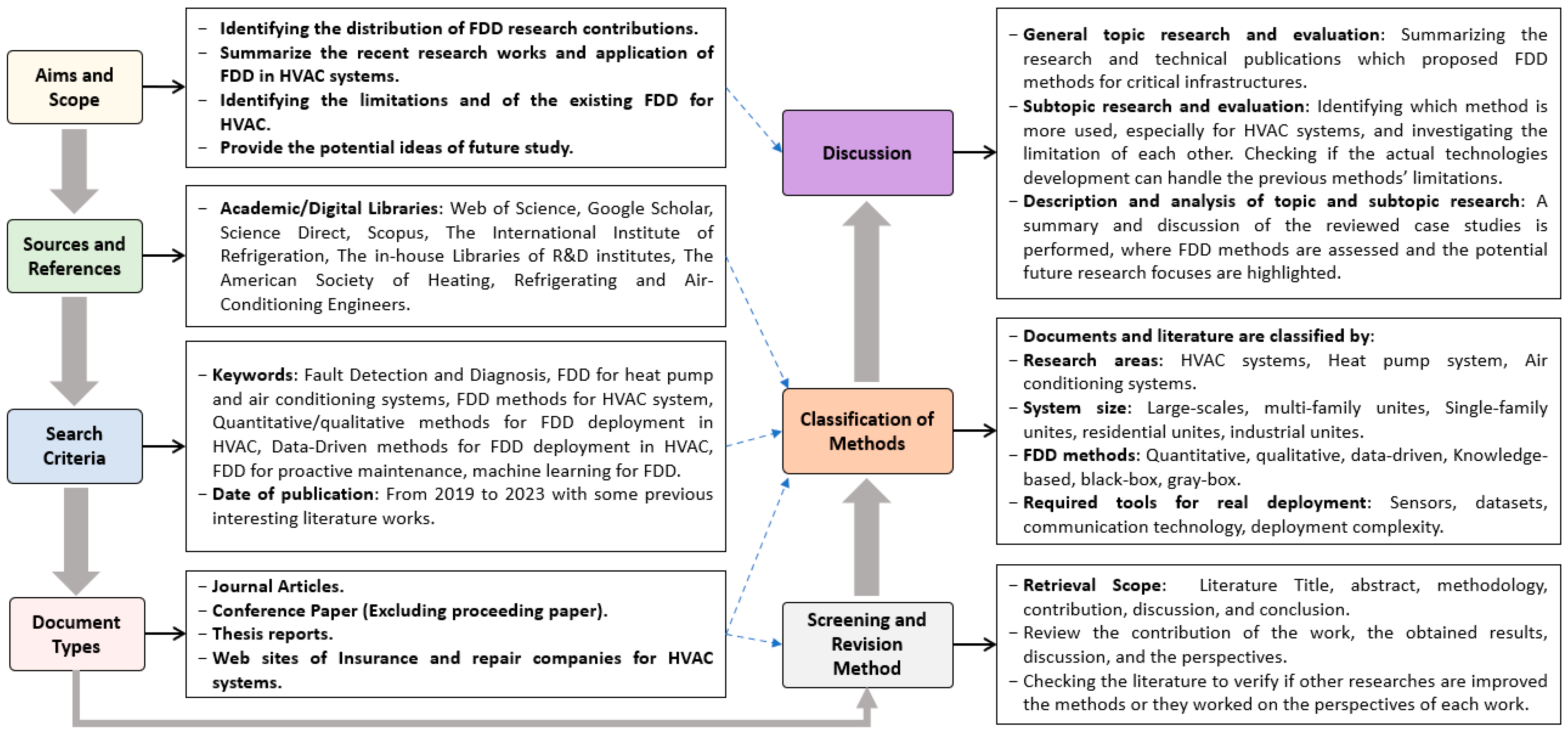
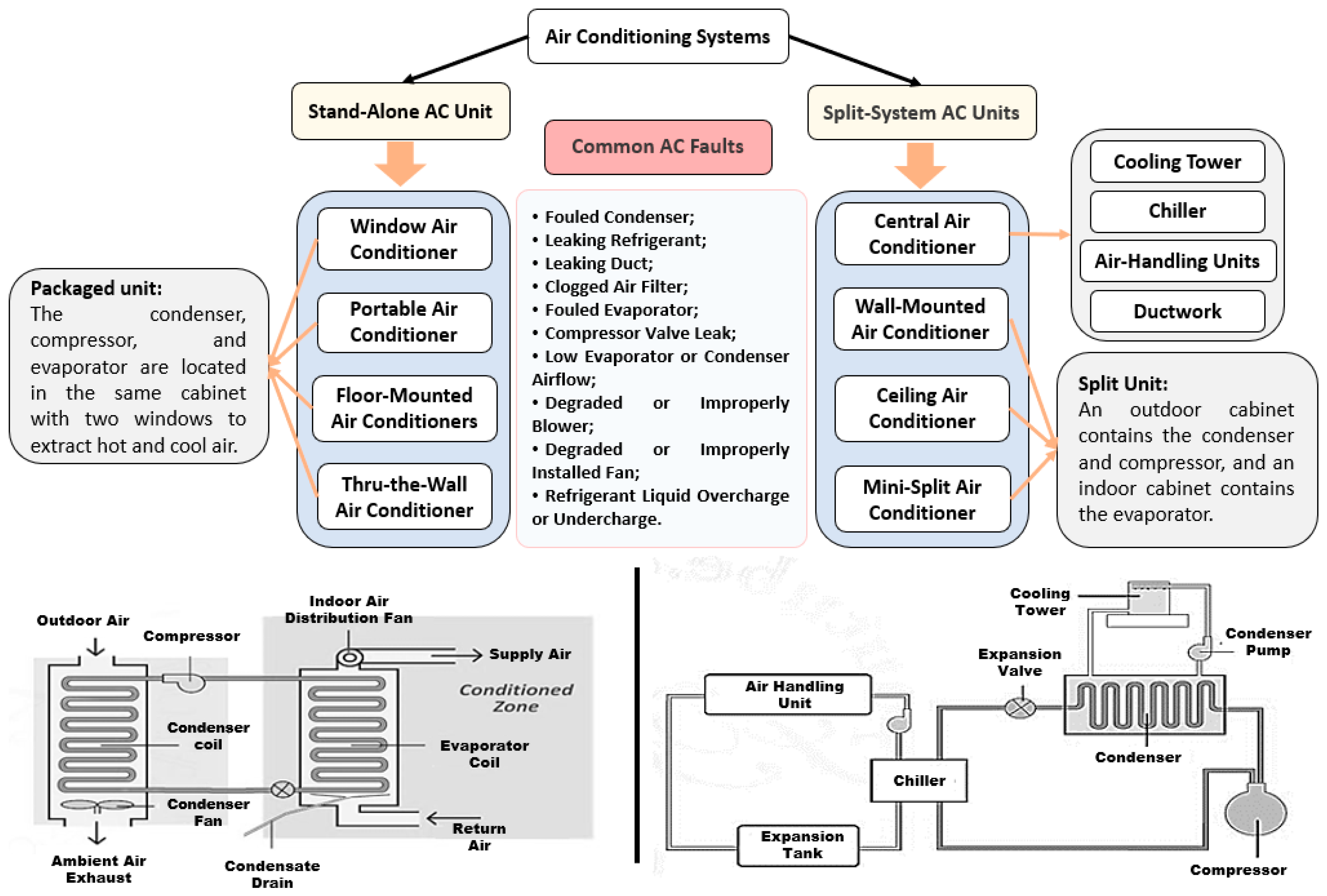

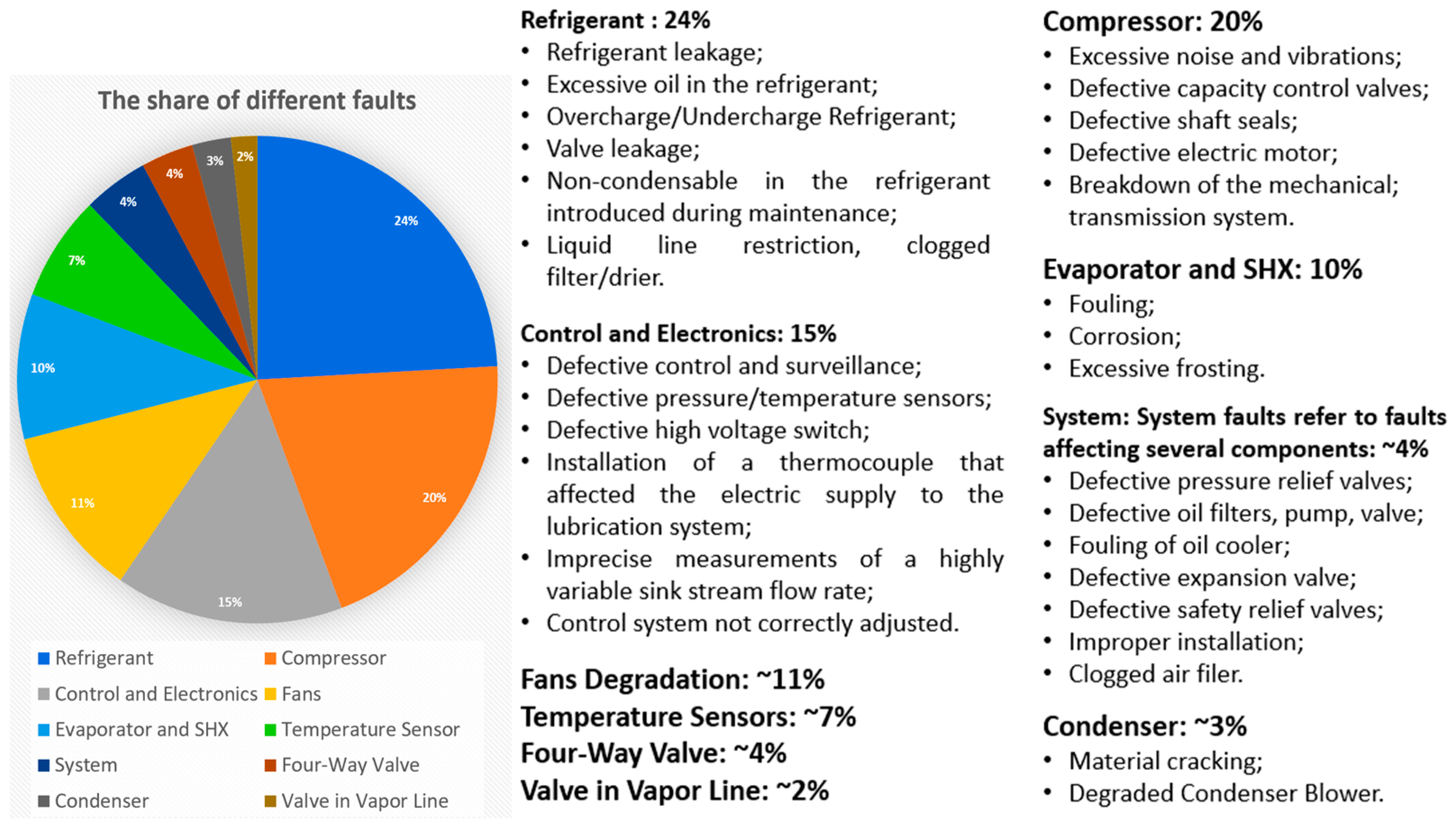
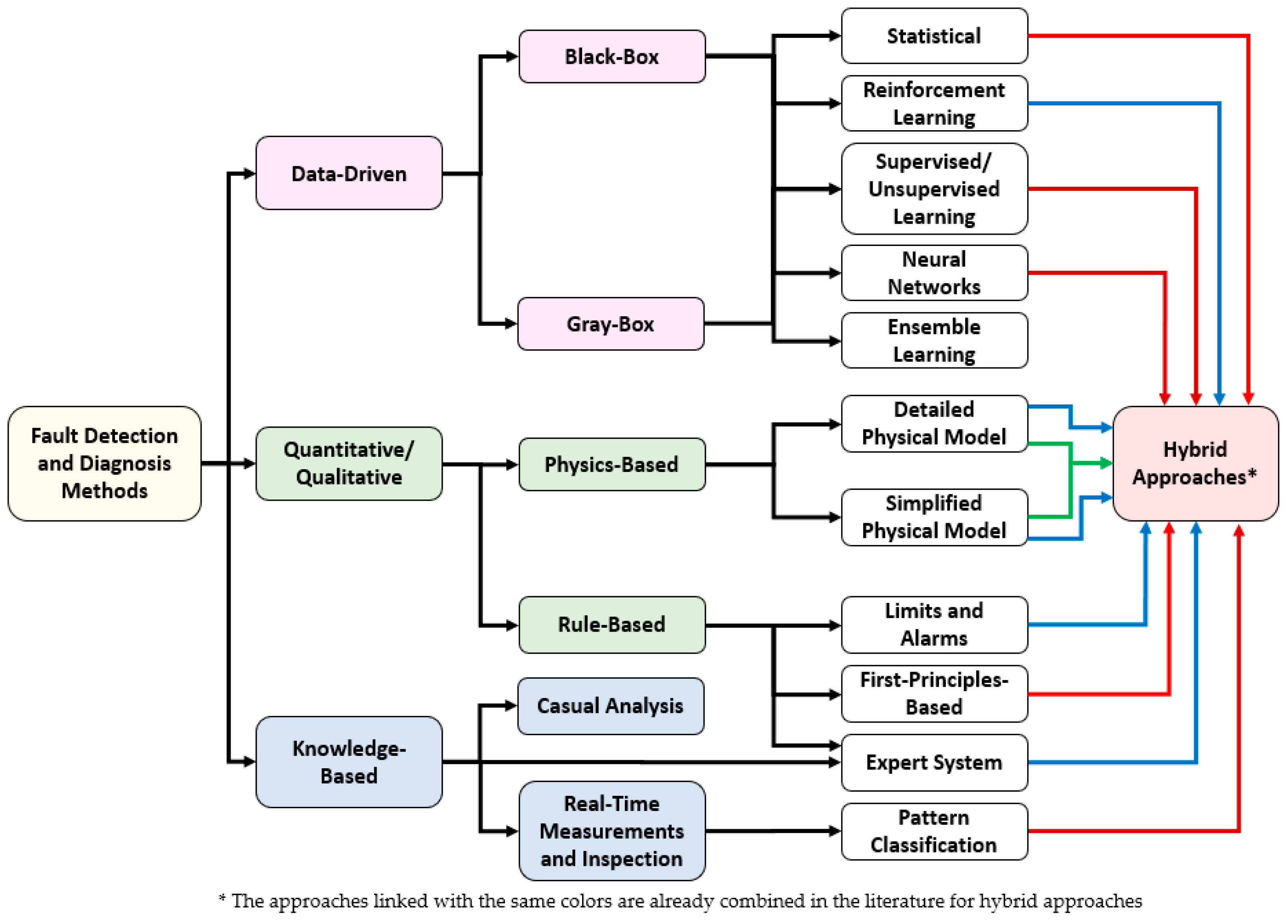
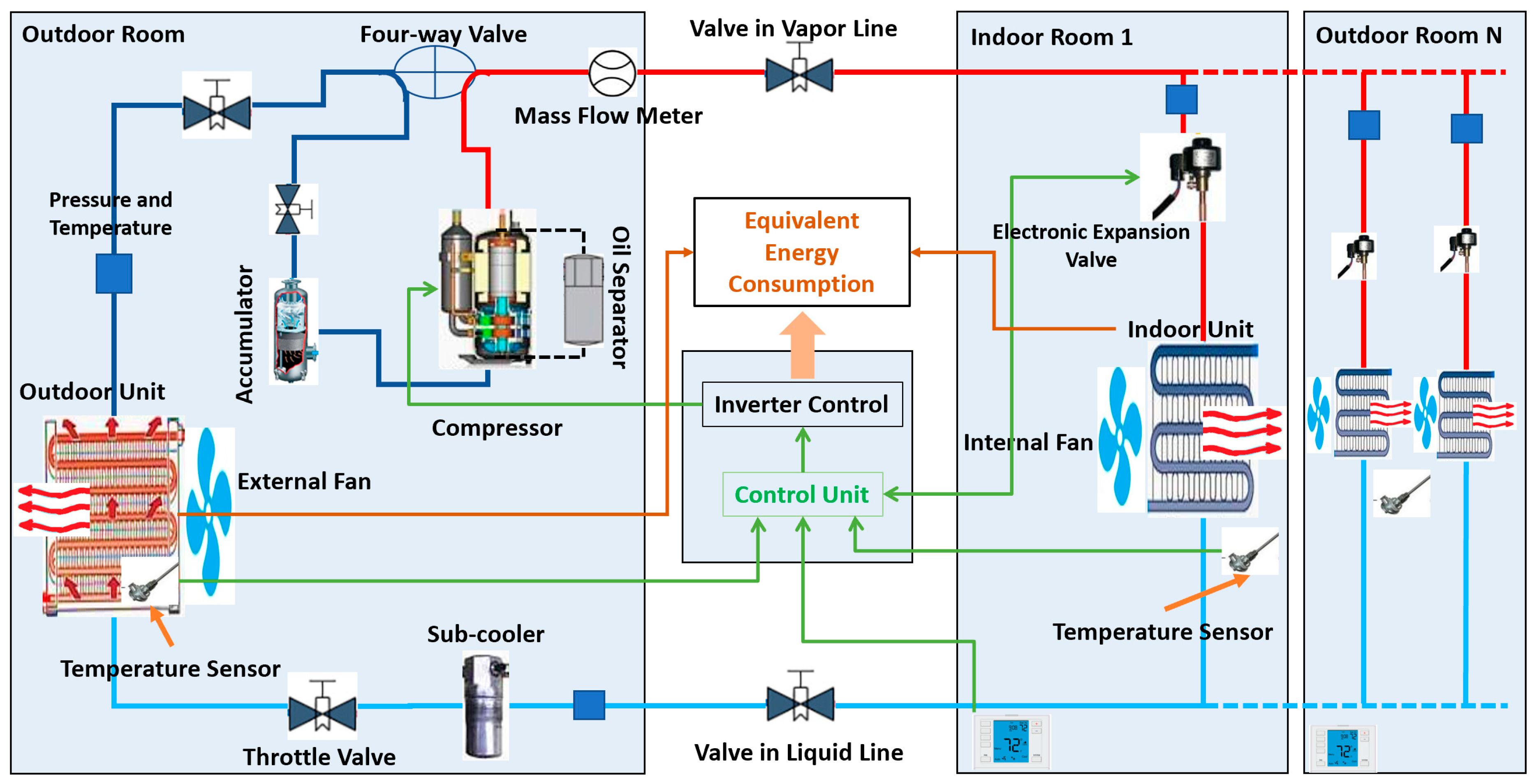
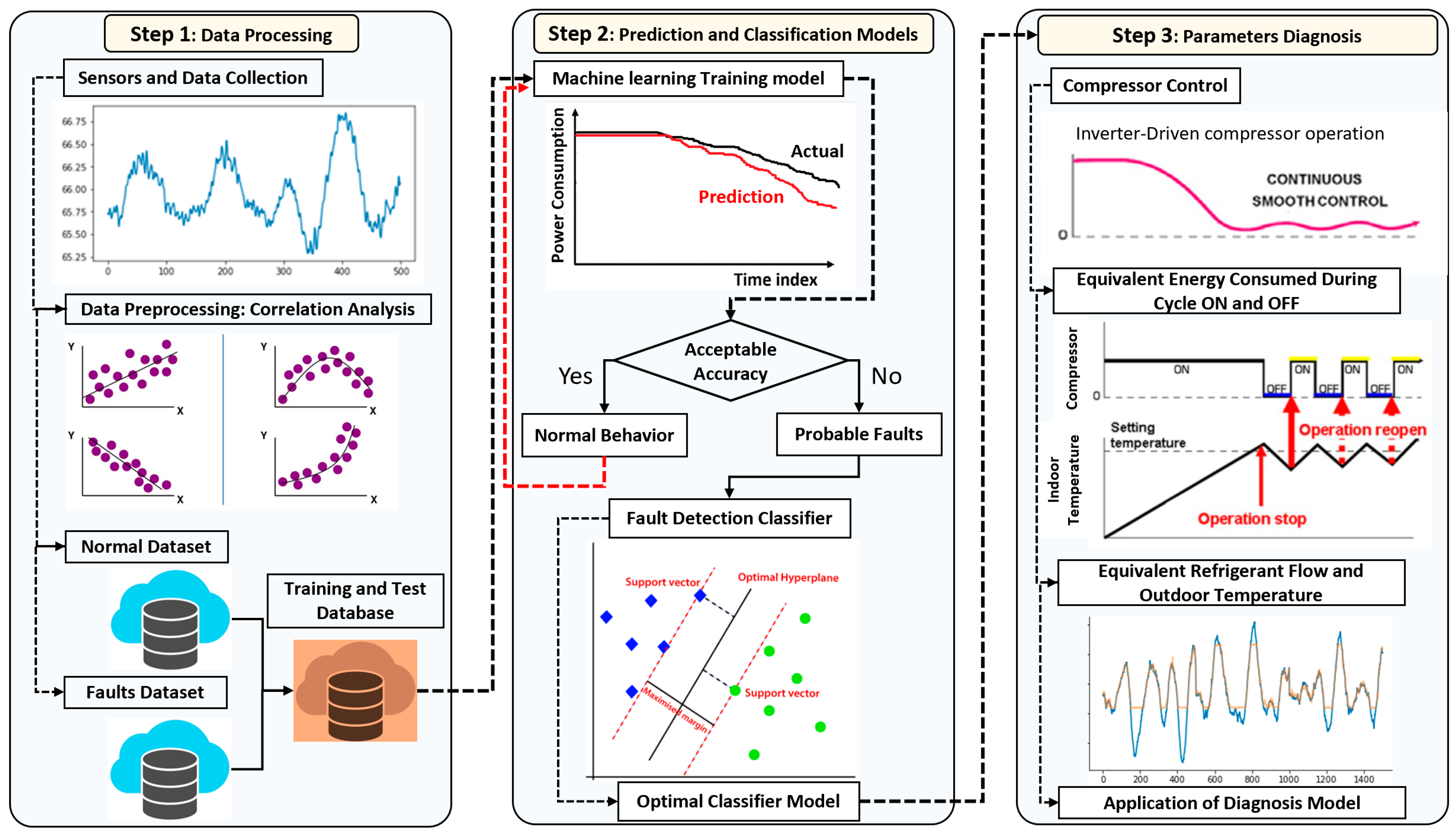

| Ref | Type Faults | Fault Investigated | Fault Detection Method | Simultaneous Faults | Fault Diagnosis | System Studied |
|---|---|---|---|---|---|---|
| [7] | Soft | Drift deviation | Combining kernel principal component analysis and double-layer bidirectional long- and short-term memory | No | No | Heating, ventilation, and air conditioning |
| [9] | Hard | Broken heating coil valve Dampers and valves control | Three algorithms are compared: an artificial neural network, a genetic algorithm, and multiple linear regression | Yes | No | Air handling units |
| [10] | Soft | Refrigerant leakages and condenser/evaporator fouling | On-field measurements and related degradation of performance | No | Yes | Residential heat pumps |
| [11] | Hard | Non-condensable gas and liquid line restrictions | Experimental study of an AC system with a microtube condenser using coefficient of performance analysis | No | No | Air conditioner with a microtube condenser |
| [16] | Hard | Refrigerant undercharge, four-way reversing valve, and indoor unit fouling faults | Fault detection strategy based on modularized principal component analysis | Yes | Yes | VRF air conditioning system |
| [17] | Hard | Liquid floodback for scroll compressor | Classification and regression trees are used to develop Decision Tree models | No | Yes | VRF air conditioning system |
| [18] | Hard | Refrigerant charge fault | Principal component analysis based on the exponentially weighted moving average method | No | Yes | VRF air conditioning system |
| [19] | Hard | Refrigerant undercharge and overcharge | Energy diagnosis method-based data mining technique and statistical quality control approach | No | Yes | VRF air conditioning system |
| [20] | Hard | Refrigerant charge fault, four-way valve failure, and compressor liquid floodback | Unsupervised principal component based on hybrid data mining methods and analyzed the thermodynamic interpretation | Yes | Yes | VRF air conditioning system |
| [21] | Hard | Compressor liquid floodback and refrigerant charge fault | Data-driven methods of analysis: Decision Tree, support vector machines, clustering, shallow neural networks, and deep neural networks. | No | Yes | VRF air conditioning system |
| [22] | Hard | Cooling tower fan failure, damper stuck, supplied chilled water clogging, and air duct leakage | Coefficient of performance analysis using deep learning, support vector machines, and multi-layer perceptron | No | No | Air conditioning system |
| [23] | Soft | The proposed method can be deployed to detect several faults | Internet of Things and cyber-physical systems: distributed sensor-fault detection and diagnosis framework | Yes | Yes | HVAC |
| [24] | Soft | Refrigerant charge faults and condenser fouling | Virtual sensors and fault impact models | Yes | No | HVAC |
| [25] | Hard | Damper stuck, air flow rate reading frozen, and low supply air static pressure failures | Proactive FDD | No | Yes | Variable-air-volume (VAV) AC systems |
| [26] | Soft | Fan, valve, and temperature sensor faults | Grey-box model approach based on polynomial regression | Yes | Yes | HVAC fan-coil |
| [27] | Hard | Refrigerant system faults | Combination of principle component analysis feature extraction technology and binary Decision Tree-based multiclass support vector machine classification algorithm | No | Yes | Vapor-compression refrigeration systems |
| [28] | Soft | Return and mixed air temperature sensor faults | Hybrid modeling approach integrating first-principles knowledge with statistical methods | No | No | HVAC |
| [29] | Hard | Obstruction of the air filters | Physics-based models with data-driven | No | Yes | HVAC |
| [30] | Soft | Condenser fouling, refrigerant leak, non-condensable refrigerant, reduced Condenser/evaporator water flow | Combining extended Kalman filter and recursive one-class SVM | Yes | No | HVAC Chiller |
| [31] | Soft | The proposed method can be deployed to detect faults in the chiller | Symbolic artificial intelligence technique based on digital twin architecture | Yes | Yes | HVAC |
| [32] | Soft | Stuck valves and temperature sensor offset faults | Evolving learning-based methods and growing Gaussian mixture regression | No | Yes | Chilled beam systems |
| [33] | Soft | The proposed method can be deployed to detect faults in the chiller | Self-attention mechanism-based temporal convolutional network | Yes | No | HVAC Chiller |
| [34] | Soft | Refrigerant charge fault, condenser fouling, and evaporator fouling | Supervised and semi-supervised machine learning | No | Yes | Rooftop units |
| [35] | Soft | Reduced condenser/evaporator water flow, refrigerant faults, excess oil, and condenser fouling | Adaptive 1D-convolutional neural network-based approach | Yes | Yes | Chiller |
| [36] | Soft | Reduced condenser/evaporator water flow, refrigerant faults, and condenser fouling | Feature-recognition model and spectral regression kernel discriminant analysis | Yes | No | Chiller |
Disclaimer/Publisher’s Note: The statements, opinions and data contained in all publications are solely those of the individual author(s) and contributor(s) and not of MDPI and/or the editor(s). MDPI and/or the editor(s) disclaim responsibility for any injury to people or property resulting from any ideas, methods, instructions or products referred to in the content. |
© 2023 by the authors. Licensee MDPI, Basel, Switzerland. This article is an open access article distributed under the terms and conditions of the Creative Commons Attribution (CC BY) license (https://creativecommons.org/licenses/by/4.0/).
Share and Cite
Elmouatamid, A.; Fricke, B.; Sun, J.; Pong, P.W.T. Air Conditioning Systems Fault Detection and Diagnosis-Based Sensing and Data-Driven Approaches. Energies 2023, 16, 4721. https://doi.org/10.3390/en16124721
Elmouatamid A, Fricke B, Sun J, Pong PWT. Air Conditioning Systems Fault Detection and Diagnosis-Based Sensing and Data-Driven Approaches. Energies. 2023; 16(12):4721. https://doi.org/10.3390/en16124721
Chicago/Turabian StyleElmouatamid, Abdellatif, Brian Fricke, Jian Sun, and Philip W. T. Pong. 2023. "Air Conditioning Systems Fault Detection and Diagnosis-Based Sensing and Data-Driven Approaches" Energies 16, no. 12: 4721. https://doi.org/10.3390/en16124721
APA StyleElmouatamid, A., Fricke, B., Sun, J., & Pong, P. W. T. (2023). Air Conditioning Systems Fault Detection and Diagnosis-Based Sensing and Data-Driven Approaches. Energies, 16(12), 4721. https://doi.org/10.3390/en16124721









